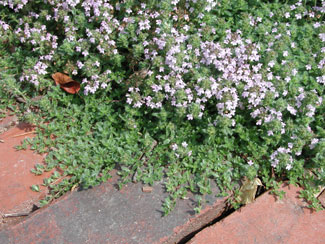Resource Library
Plant of the Week: Thyme, Creeping, Mother of Thyme
The University of Arkansas System Division of Agriculture does not promote, support or recommend plants featured in "Plant of the Week." Please consult your local Extension office for plants suitable for your region.
Plant of the Week
Thyme, Creeping, Mother of Thyme
Latin: Thymus praecox

With all the changes to Latin plant names in the past few years, it seems common names may be more stable. But then when I tried to sort out the true identify of a plant I have always called “creeping thyme,” I found half a dozen species bearing this common name. The creeping thyme I was looking for turns out to be Thymus praecox and is sometimes called Mother of Thyme.
Creeping thyme is a 2- to 3-inch tall aromatic creeper that may spread several feet across. It is technically a woody perennial but the woody portion of the plant is not very woody and then only near the base of the plant. About 350 species of thymes have been described with the genus belonging to the mint family. Most are native to the Mediterranean region of Southern Europe, Central Asia and Northern Africa. Many species are grown in the herb garden and perennial border and they are often misidentified in garden centers and nurseries.
Pairs of tiny fragrant, oval, entire margined, and sometimes, wooly, pubescent, evergreen leaves are produced opposite one another on the creeping, wiry stems. Flowers are usually lavender in color and borne in dense heads at the ends of short upright stems and appear in mid spring. Individual flowers are a quarter-inch across have a tubular corolla with the lower lip divided into three prominent lobes with the upper lip smaller.
Thymes have a long history of cultivation with the name itself taken from what the ancient Greeks called it. The plants were spread throughout Europe by the Romans who used it in to an extent in cookery but more often for its aromatic properties. Egyptians used it in embalming; Greeks burned it as incense in their temples to provide courage, while Romans used it to purify their rooms and as a flavoring in drinks and cheeses. In the Middle Ages, harkening back to the beliefs of the Greeks, bunches of the herb were placed beneath pillows to ward off nightmares and bundles given to knights as they marched off to fight in the Crusades.
Modern day usage is in cooking and for extraction of the essential oil, thymol, which
is primarily extracted from T. vulgaris. This essential oil has antiseptic properties and is the principal active ingredient
in mouthwashes such as Listerine.
Creeping thyme is primarily used as an ornamental groundcover in rock gardens, herb
gardens, as a front-of-border edging and between pavers in garden paths. When used
in walkways the soil should be recessed because thymes do not tolerate foot traffic.
It requires full sun and a well-drained, somewhat dry site. Frequent watering via
an automatic irrigation system will kill it off but it can also be taken out by prolonged
drought or competition for water with nearby trees. Fertilization is not recommended.
In well-drained soils in rock gardens it spreads quickly the first couple years but after three or four years the original part of the plant will become thin and begin dying. When this happens the plant should be divided in late winter and new, vigorous divisions used to reestablish it. Being so short in stature, it must be planted away from taller, more aggressive plants.
By: Gerald Klingaman, retired
Retired Extension Horticulturist - Ornamentals
Extension News - July 12, 2013
The University of Arkansas System Division of Agriculture does not maintain lists of retail outlets where these plants can be purchased. Please check your local nursery or other retail outlets to ask about the availability of these plants for your growing area.